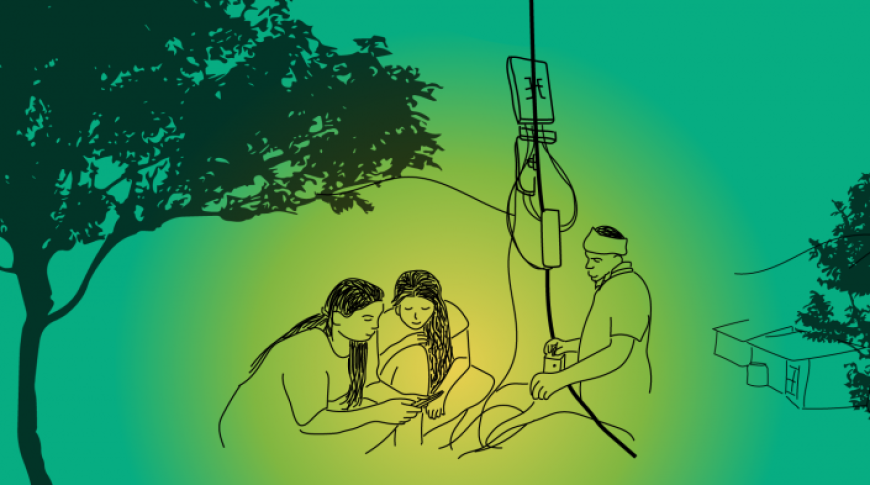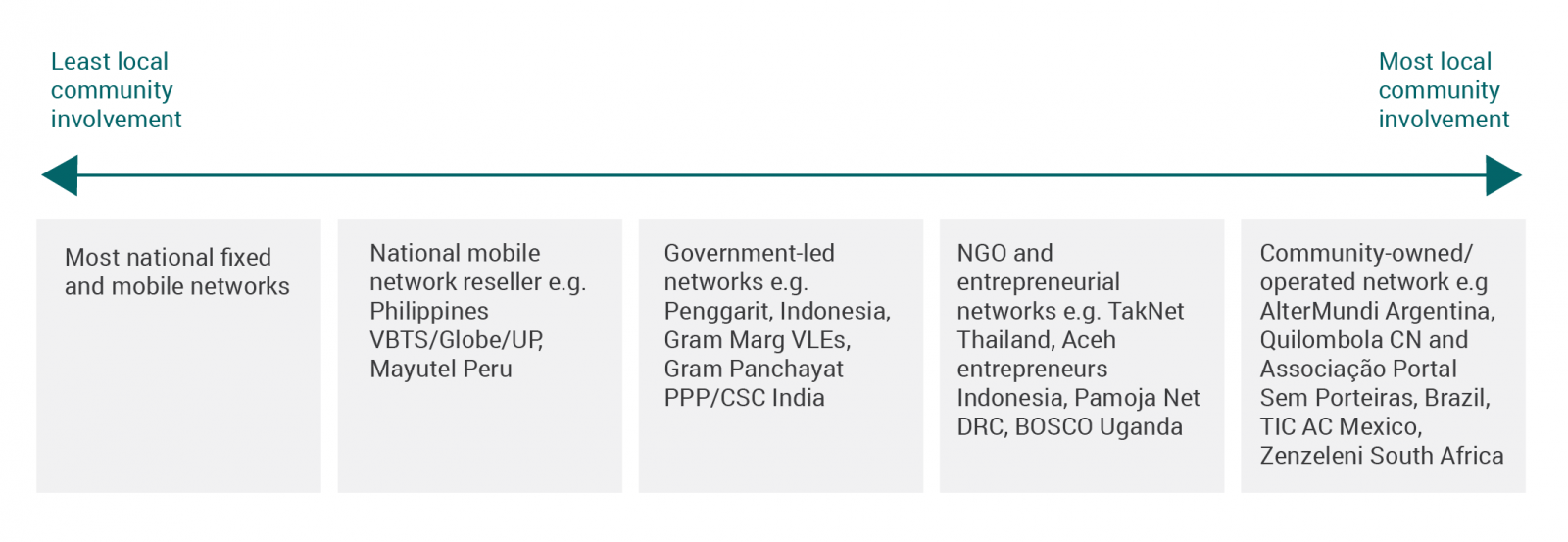
The research publication "Bottom-up Connectivity Strategies: Community-led small-scale telecommunication infrastructure networks in the global South", authored by Nicola J. Bidwell and Michael Jensen and launched in 2019, studied the benefits of, and challenges facing, small-scale, community-based connectivity projects. The report presented the findings gathered through visits to 12 rural community networks in the global South, in addition to information on a number of others compiled through desk research and interviews. The ultimate goal of the research was to contribute to creating a more enabling environment for small community-based local access networks to grow and flourish, given the vital role that they can play in providing connectivity for the billions who have been left behind by current strategies that view local access as the “last mile” as opposed to the “first mile”. Although the entire report was made freely available online as soon as it was completed, we have decided to launch this series of articles, each highlighting a particular aspect of the research.
In previous weeks we looked at the reasons for conducting this research and learned more about the community networks that were studied during the research, their motivations for building their own communications networks, and the technical and operational strategies of the community networks studied during the research. This week we look at the different institutional models adopted by these networks.
The institutional models exhibited by community networks vary considerably. These range from networks run and/or supported by non-profit member associations, cooperatives and small businesses, to NGO projects and partnerships between government and academic institutions. Local authorities have a significant role in many of the networks, although these institutions vary in terms of their involvement and relationship with the “grassroots” community that may own and operate the network.
It should also be noted that five of the community networks studied for the research have close relationships with, or even emerged from, initiatives to operate community radio stations: AlterMundi/QuintanaLibre (Argentina), BOSCO (Uganda), Pamoja Net (DRC), TIC AC (Mexico) and W4C (India). This is perhaps not surprising given the similar objectives that community radio stations usually have around improving access to communications and information, along with their infrastructure resources such as high towers and power.
Provisioning models
The community network initiatives studied for the research can be grouped into three models which reflect their institutional strategies: a) self-provisioning of connectivity, b) entrepreneurial provision of connectivity, and c) externally supported provision of connectivity. These may be called “business models”, but the term is avoided here because so many of these networks do not operate as a business in the traditional sense.
In the self-provisioning group, members of the community have established and operate the network mainly on a cost-recovery basis and largely with their own resources. Some of these networks started informally and grew relatively slowly, but are largely independent of outside support, and their governance models are usually based on participatory structures such as a non-profit association, traditional assemblies or a consumer cooperative.
In the entrepreneurial provision group, a local business or informal commercial enterprise sells connectivity services to end-users, usually as an addition to other existing business activities and in most cases supported by an umbrella organisation. Similarly to the self-provisioning model, some have established their community network without external resources and grew organically. However, some operate as part of a more complex and mixed model structure, where, for example, the infrastructure is established and maintained as a non-profit by one entity and businesses simply sell air-time or access vouchers. Although the pure entrepreneurial approach may be focused on the jobs or income potential that can be derived from a market opportunity, where they have low overheads and operational proximity to the end-users, these networks can be more affordable and potentially more responsive to community needs than larger commercial operators.
The externally supported group is the largest and most diverse among the network groups examined. There are essentially two sub-groups here: a) development organisations providing connectivity as part of broader rural upliftment activities, and b) research organisations setting up pilot projects to test technologies and institutional models. It can be observed that a number of initiatives in this group also contain elements of the other two groups, or are transitioning to the entrepreneurial provision model or to the self-provisioning model. In this respect, it should be noted here that while the strategies and sustainability models are stable in some of the networks, in others they are still emerging.
Umbrella and support organisations
One particularly important observation emerging from the research is that most of the initiatives studied have an additional institutional layer – an “umbrella” or support organisation – that provides the individual community networks with various resources. This is to be expected in the externally supported networks, but is also evident in the other models, with their supporting organisations based in towns or cities at some distance from the operating networks in the rural villages. The three main ways that support to individual networks is provided by these umbrella organisations are by:
- Operating shared network infrastructure as resources which are used by the individual networks, such as high sites/backhaul links and voice gateways. This also has parallels with some of the developed country community networks, such as guifi.net, where shared network resources are treated as a “commons” and are managed as common-pool infrastructure.
- Centralising technical and administrative support. This can be related to the design and operation of shared infrastructure, which often requires experienced technicians to configure mobile base stations, for example, or scaling Wi-Fi networks to share bandwidth and calculate link budgets to optimise long-distance links. In addition, centralised technical support can reduce the need for each local network to replicate all of the often scarce human resources required to operate and maintain the network.
- Acting/negotiating on behalf of individual networks in relations with government, suppliers and partners, such as in licensing, obtaining internet links and fundraising. This usually also includes support for the development of community networks in the country more generally, such as by raising awareness of the potential of community networks and lobbying for their support by policy makers and regulators.
Overall, it is apparent that the presence of the umbrella organisations helps to avoid unnecessary replication of network resources at each location, and is also a response to the difficulties of supporting widely scattered rural networks with limited local availability of skills, helping to address the need for scale in these environments. Since these umbrella organisations are usually located in a city, this also allows them to be closer to upstream capacity providers, equipment vendors, donors, spheres of political influence and offices where paperwork is required.
Levels of community involvement
Figure 1 is a simplification of the situation, but illustrates how networks can be roughly divided into five groups spread across a spectrum of levels of community involvement. These groups are also associated to a greater or lesser extent with different institutional models.
Figure 1. Networks divided into five groups in relation to community involvement

Different levels of community involvement and related institutional models reflect local and national cultures and socioeconomic contexts. In particular, strategies largely result from different approaches to coping with the hostile or non-existent policy and regulatory environments which exist for community networks.
Depending on the legal environment for cooperatives vs. non-profit associations and clubs, the cooperative or non-profit membership association models appear particularly well suited to these community network endeavours. Rural cooperatives in telecommunication, energy production, savings, agriculture and food distribution have already existed for decades in both developed and developing countries. So it appears these models may become more widely adopted among community networks, given the objective of providing affordable communications combined with the cultures of resilience, community involvement and resource sharing present in rural areas, or provoked by community networks. These models also fit well with network topologies comprised of wireless links between neighbouring homes which share the available capacity.
Coming next week: Bottom-up Connectivity Strategies: What are the local and global benefits offered by community networks?
Find out more about the research methods here.
DOWNLOAD THE FULL RESEARCH "Bottom-up Connectivity Strategies: Community-led small-scale telecommunication infrastructure networks in the global South" [PDF]
This report was produced as part of the broader Local Access Networks project that was carried out in partnership with Rhizomatica (an NGO supporting numerous community networks in Latin America) with financial support from the International Development Research Centre (IDRC).
Short accounts of other community network initiatives can be found in the sister publication also produced as part of this project – Global Information Society Watch 2018: Community Networks – which looks at networks in 43 countries.